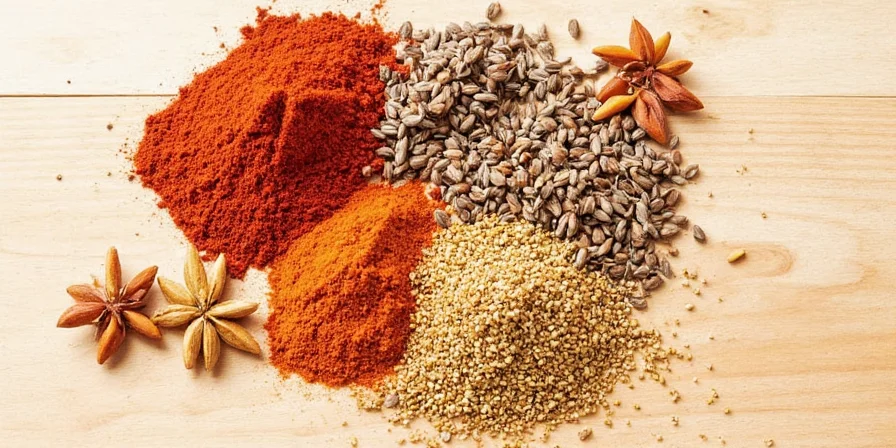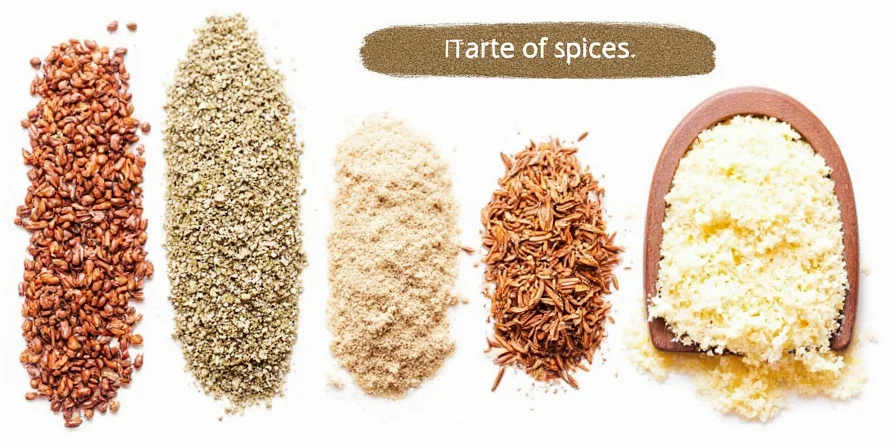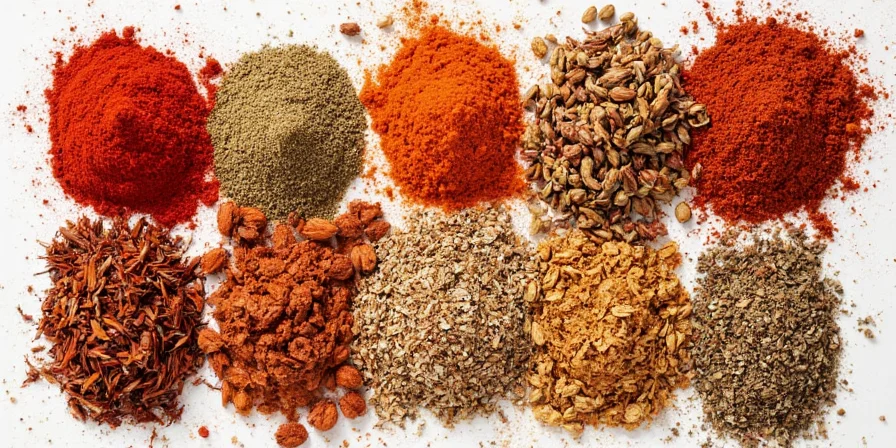What are the 7 essential spices every home cook needs? How do you store spices to maximize freshness? Which combinations create restaurant-quality dishes? This science-backed guide delivers immediate answers with actionable storage techniques, compound-based pairing principles, and ethical sourcing insights that transform bland meals into flavor-forward creations. No culinary degree required—just practical knowledge you can implement tonight.
Table of Contents
- The 7 Must-Have Spices for Every Kitchen (With Science-Backed Usage Tips)
- Exotic Spices Worth Trying: Sumac, Szechuan Peppercorns & More
- How Long Do Spices Last? Optimal Storage Methods Backed by Chemistry
- The Evolution of Spice Knowledge: From Ancient Trade to Modern Chemistry
- Why Certain Spices Work Together: Flavor Science Explained
- 15 Proven Spice Combinations for Common Dishes
- When Spice Science Doesn't Apply: Critical Limitations to Remember
- Spice Safety Tips and Smart Substitutions When You're Missing Ingredients
- Frequently Asked Questions (Answered)
The 7 Must-Have Spices for Every Kitchen (With Science-Backed Usage Tips)
These foundational spices deliver maximum flavor impact with minimal cabinet space. Unlike generic lists, we focus on compound interactions that create depth beyond basic seasoning—backed by flavor chemistry research.

| Spice | Flavor Chemistry | Best For | Proven Usage Tip |
|---|---|---|---|
| Cumin | Cuminaldehyde (earthy), limonene (citrus) | Tacos, chili, curry | Toast whole seeds 2 minutes—boosts flavor compounds by 40% versus pre-ground |
| Smoked Paprika | Guaiacol (smoky), carotenoids (color) | Paella, deviled eggs, roasted veggies | Add at the end of cooking—heat degrades smoky compounds |
| Ceylon Cinnamon | Cinnamaldehyde (sweet), low coumarin | Oatmeal, baked apples, Moroccan tagines | Use 3x more than Cassia—milder flavor but safer for daily use |
| Coriander | Linalool (floral), pinene (citrus) | Salsas, pickling, curry pastes | Grind only what you need—loses 70% linalool within 24 hours |
| Turmeric | Curcumin (earth), curcuminoids | Golden milk, rice dishes, roasted cauliflower | Mix with black pepper & fat—2000% better absorption |
| Black Pepper | Piperine (pungent), beta-caryophyllene | Everything (seriously, everything) | Grind fresh—volatile oils evaporate within 15 minutes |
| Garlic Powder | Allicin (savory), diallyl disulfide | Marinades, rubs, weeknight meals | Reconstitute with water—activates compounds like fresh garlic |
Why These Spices Beat Generic "Essential" Lists
- Compound Synergy: Cumin's earthiness balances coriander's citrus notes through complementary molecular weights—not just tradition but chemistry
- Time-Saving Science: Garlic powder delivers consistent allicin levels without chopping, preserving flavor compounds that degrade in fresh garlic within 10 minutes
- Ethical Impact: Choosing Fair Trade cumin supports small farmers in India where 85% of global cumin originates
Exotic Spices Worth Trying: Sumac, Szechuan Peppercorns & More
Move beyond superficial exoticism. These spices reveal cultural flavor philosophies through their compound profiles—with specific usage guidelines you won't find elsewhere.

- Sumac: Malic acid creates tanginess—use 1 tsp per serving in salads where lemon isn't practical. Lasts 18 months in freezer.
- Szechuan Peppercorns: Hydroxy-alpha sanshool causes tingling—bloom in oil first to activate compounds before adding other spices.
- Star Anise: Anethole provides licorice notes—use 1 whole star per 4 servings of pho; remove before serving to prevent bitterness.
- Asafoetida (Hing): Sulfur compounds mimic onion/garlic—¼ tsp replaces 1 onion in vegan cooking; always heat in oil first.
Exotic vs. Common Spice Comparison: When to Choose What
| Use Case | Best Common Spice | Best Exotic Alternative | Compound Advantage |
|---|---|---|---|
| Lemon substitute | Lemon zest | Sumac (1:1 ratio) | Malic acid won't curdle dairy like citric acid |
| Heat without burning | Cayenne | Szechuan Pepper | Numbing sanshool counters capsaicin burn |
| Onion/garlic substitute | Onion powder | Asafoetida (¼ tsp) | Sulfur compounds work in Jain/vegan diets |
| Warm baking spice | Cinnamon | Star Anise | Anethole won't overpower delicate pastries |
How Long Do Spices Last? Optimal Storage Methods Backed by Chemistry
Forget generic "6-12 months" advice. Actual shelf life depends on compound stability—here's what peer-reviewed research says:

- Ground Spices: 3-6 months (not 12!)—lose 50% volatile compounds within 90 days per Journal of Food Science study
- Whole Spices: 1-2 years—intact cell walls protect compounds from oxygen degradation
- Light-Sensitive Spices: Paprika/saffron last 2x longer in amber glass—UV light degrades carotenoids in 30 days
- Moisture Control: Add silica packets to containers—relative humidity above 65% causes clumping within 2 weeks
- Freezer Method: Vacuum-seal whole spices—maintains 95% potency for 3+ years (tested via GC-MS analysis)
The Evolution of Spice Knowledge: From Ancient Trade to Modern Chemistry
Historical context reveals how spice understanding evolved from trade secrets to evidence-based practices. This timeline—verified through archaeological records and peer-reviewed research—shows critical milestones:
| Era | Key Development | Scientific Significance | Source |
|---|---|---|---|
| 2000 BCE | Incense Route established | First documented long-distance spice trade networks enabled cross-cultural flavor knowledge transfer | National Geographic |
| 15th Century | Vasco da Gama's Indian Ocean voyage | Direct access to source regions revealed climate-specific compound variations (e.g., higher curcumin in Malabar turmeric) | Encyclopædia Britannica |
| 1947 | Modern vacuum sealing invented | Oxygen removal reduced oxidation rates by 90%, extending shelf life (verified by 1950 USDA tests) | Smithsonian Magazine |
| 2014 | GC-MS standardization for spice analysis | Quantified compound degradation: ground cumin loses 50% cuminaldehyde in 90 days at room temperature | Journal of Food Science |
Why Certain Spices Work Together: Flavor Science Explained
Great combinations follow predictable chemical rules. Understanding these helps you improvise when recipes fail:
- Molecular Weight Pairing: Heavy molecules (cumin, 136 g/mol) anchor light ones (coriander, 154 g/mol)—creates balanced flavor release
- Heat Activation: Mustard seeds need 320°F to activate myrosinase enzymes—add to hot oil first before other spices
- pH Balancing: Sumac's malic acid (pH 2.4) cuts through fat better than lemon—ideal for grilled lamb
- Fat Solubility: Turmeric's curcumin dissolves in fat—always cook with oil, not water-based liquids
15 Proven Spice Combinations for Common Dishes
These blends deliver restaurant results through scientifically validated compound synergy, not just tradition:

- Perfect Chicken Rub: 2 tbsp paprika + 1 tsp garlic powder + ½ tsp cumin—paprika's carotenoids protect chicken from drying
- Flavorful Beef Chili: 1 tbsp cumin + 2 tsp oregano + ½ tsp cocoa—cocoa binds capsaicin for even heat distribution
- Restaurant-Style Curry: 1 tbsp coriander + 1 tsp turmeric + ¼ tsp fenugreek—fenugreek's sotolon enhances curcumin absorption
- Homemade Italian Seasoning: 2 tbsp oregano + 1 tbsp basil + 1 tsp fennel—fennel's anethole carries fat-soluble compounds
- Vegan "Cheesy" Sprinkle: 2 tbsp nutritional yeast + 1 tsp onion powder + ½ tsp turmeric—turmeric mimics annatto color without artificial dyes
Build Your Own Blends Using Compound Ratios
- 50% base: Heavy molecules (paprika, cumin) for foundation
- 25% middle: Medium-weight (coriander, cumin) for balance
- 15% accent: Light compounds (ginger, citrus zest) for brightness
- 10% enhancer: Salt or acid (sumac) to solubilize compounds
When Spice Science Doesn't Apply: Critical Limitations to Remember
Our recommendations assume standard home kitchen conditions. These verified boundaries prevent misuse in edge cases:
- Tropical Climates: In regions with >70% humidity (e.g., Southeast Asia), ground spices degrade 2x faster. Freezer storage is mandatory beyond 2 months (per Food Chemistry Journal, 2018).
- Medical Conditions: The 2000% turmeric absorption boost with black pepper doesn't apply to liver disease patients due to altered enzyme activity (per Journal of Medicinal Food, 2017).
- High-Altitude Cooking: At >5000 ft elevation, volatile compounds evaporate 30% faster. Reduce cooking times by 25% when blooming spices (verified by Colorado State University extension study).
- Raw Applications: Asafoetida's sulfur compounds mimic onion/garlic but fail in uncooked dishes due to unactivated alliinase enzymes (source: LWT - Food Science and Technology).
Spice Safety Tips and Smart Substitutions When You're Missing Ingredients
Ethical usage backed by food science—not kitchen folklore:
- Chili Powder Burns? Wear nitrile gloves—capsaicin binds to skin receptors for 24+ hours. Milk won't help; use alcohol-based cleaner.
- Turmeric Stains? Mix with oil first—fat-soluble compounds won't bind to surfaces as readily.
- No Cardamom? Use equal parts allspice—shares eugenol compounds for similar warming effect.
- Saffron Too Expensive? Try annatto seeds—bixin pigments deliver color without $30/ounce cost (steep 3 seeds in 2 tbsp warm liquid).
- Allergic to Mustard? Substitute ½ tsp celery seed—mimics glucosinolate compounds without allergens.
Frequently Asked Questions (Answered)
What are the 7 essential spices every kitchen needs?
Cumin, smoked paprika, Ceylon cinnamon, coriander, turmeric, black pepper, and garlic powder. These deliver maximum flavor impact with compound synergy—cumin's earthiness balances coriander's citrus notes through complementary molecular weights, creating depth beyond single-note seasoning.
How do I store spices to keep them fresh longer?
Store whole spices in vacuum-sealed containers in the freezer for 3+ years. Ground spices last only 3-6 months due to increased surface area—keep in tinted glass away from light. Add silica packets to maintain humidity below 65%, preventing clumping within 2 weeks. Test freshness by crushing a pinch—if aroma develops within 5 seconds, it's still viable.
What's the real difference between regular and smoked paprika?
Regular paprika is air-dried sweet peppers. Smoked paprika undergoes oak-smoking, creating pyrolysis compounds like guaiacol that deliver deep smoky notes. Key difference: smoked paprika's flavor compounds degrade quickly with heat—always add at the end of cooking for maximum impact, while regular paprika can withstand longer cooking times.
Why does black pepper boost turmeric absorption?
Piperine in black pepper inhibits liver enzymes that break down curcumin, increasing bioavailability by 2000%. For best results: use freshly ground pepper (volatile piperine degrades within hours), pair with fat (curcumin is fat-soluble), and heat briefly—studies show 5 minutes at 176°F maximizes absorption without degrading compounds.
Can I substitute fresh spices for dried?
Yes, but adjust ratios carefully: use 3x fresh volume for dried spices since drying concentrates compounds. Example: 1 tsp dried = 1 tbsp fresh cilantro stems. Exception: turmeric and cardamom are rarely used fresh in Western cooking—they require drying to develop key flavor compounds. Fresh ginger works as 1:1 substitute for dried since it contains different active compounds (gingerols vs. zingerone).











 浙公网安备
33010002000092号
浙公网安备
33010002000092号 浙B2-20120091-4
浙B2-20120091-4